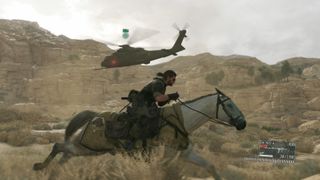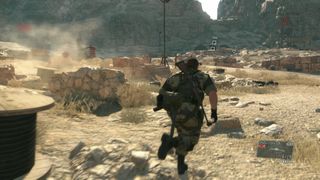Metal Gear Solid 5 delivers spectacular open world stealth

And then there’s the option in certain missions to never even consider approaching the map’s most dangerous areas but to set traps and wait for your targets to come to you. In one early mission, an assassination attempt can be completed in a matter of seconds by pre-empting your target’s movements and booby-trapping the route to a stronghold with C4 explosives, rather than taking the obvious path and playing a game of hide-and-sneak behind enemy lines for 30 minutes.
Going loud also lets one of sandbox world’s most interesting new game mechanics shine: enemy backup squads. When you’re in the field, enemies won’t spawn into the map but move from area to area. So set off an alarm in one facility and the soldiers there will radio for backup from neighbouring outposts. Blow up that base’s communications satellite first, and the radio signal isn’t getting through. Or, clean out the neighbouring camps prior to the main base and that radio message will be transmitted—but it’ll be met with a returning communiqué explaining that no backup forces are in the area to assist.
Aside from abusing this game mechanic to cunningly drag soldiers away from one target to another, I’m able to employ my Fulton recovery balloon system (which you attach to objects and people to airlift them out of the world and back to your base) to weaken enemy fortifications ahead of activating objectives. With missions manually activated via Snake’s iDroid menus, I can sneak into a base ahead of time, hook balloons to gun emplacements and guards and send them back to Mother Base for bonuses, then exit the area and activate the mission. When the objective begins my job’s made significantly easier because of the reduced defences and the lack of spawning—subverting the mission mechanics in this manner is positively encouraged.

This playfulness is classic Hideo Kojima monkeying at its best. As is the ostentatiousness of Snake’s absurd abilities. Dive off the side of a hill while wearing a cardboard box and Snake will toboggan down the slope. Slap a cutout of a bikini-clad babe to the same box and guards will swoon at your disguise—letting you push open the cardboard flaps for a surprise headshot. Beat up recruited soldiers back at Mother Base and your victims will only reply with sincere praise. “It was an honour, sir!” they yell, glad to have aided in your CQC training.
While other journalists are busy trying to speedrun the main missions in an effort to complete the game (after 14 solid hours of playing, it should be noted, no one did), I find myself distracted by wildlife hunts. As a side activity, Snake’s charged with rescuing creatures from the combat zone, and so I patrol the Afghan desert riding a wheeled bipedal mech called a Walker Gear, tranquillising everything that moves, Fulton ballooning larger creatures such as donkeys and bears and griffon vultures up into the sky and back to HQ, and stuffing my pockets with rats and other critters too small for the balloon journey. Luckily, my Mother Base home also boasts a series of platforms filled with animal cages and aviaries to create my very own floating zoo.
This HQ forms a large part of The Phantom Pain. Away from Metal Gear’s usual diet of stealthing, box-hiding and shootouts, Snake has a facility of his own to upgrade and manage. Typically this is done in tandem with his field work: picking up boxes of resources, and subduing and Fulton ballooning guards while on a mission, is the core means of boosting HQ’s stats. That’s only part of the job, however. A large part of the game involves moving different recruits to different tabs in the game’s menus to best utilise their skills. Every NPC in the game is graded for different abilities (Research & Development, Combat, Support, Intel, Medical and so on), and it’s my job to ensure the best person is assigned to the most appropriate team in order to maximise efficiency in the field. The better the Intel team, the more items and enemies I have flagged up on my map heading into a base infiltration mission, for instance.

Where this base management approaches Football Manager turf is in its R&D section. Essentially, the better the recruits working in the R&D wing, the more weapons and gear you can develop (provided you also possess the required resource types and GMP. And so I find myself in a situation where I desperately need a rocket launcher to destroy a tank in my current mission but I’m without the R&D resources to develop it. Fulton ballooning a couple more soldiers back to base and then juggling around the assigned R&D team members in the menus once they’ve arrived a few seconds later, however, tips my stats over the required threshold and unlocks the kit I need. All that’s left to do is call in a supply drop and have my shiny new toy parachuted to my location and ready for action—all this within the space of a minute.
The biggest gaming news, reviews and hardware deals
Keep up to date with the most important stories and the best deals, as picked by the PC Gamer team.
It’s largely new territory for the series, and for the first time it feels as though Kojima has allowed himself to be influenced by other games. Sending recruits off to complete global missions in the menus has the fingerprints of Assassin’s Creed all over it, while the ability to pick and choose the order of story mission batches in the open world is Grand Theft Auto-like. But Metal Gear Solid has always celebrated player choice, and that’s what these extra layers represent: more control over how your adventure unfolds, and more say in how you best evolve your play style.
Those seeking the classic Metal Gear experience should know The Phantom Pain doesn’t disappoint when it comes to corner-hiding, throat-stabbing espionage—but to play it in this manner requires some extreme restraint when the game is urging you to experiment with all it has to offer.
Most Popular

